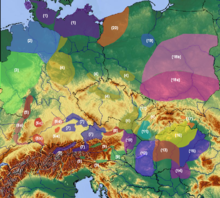Singen group
The Singener Gruppe refers to an early Bronze Age regional group in southern Germany. It was named after the group's only known site, a burial ground near Singen , which was discovered in 1950. The necropolis excavated there is one of the largest in West Germany. As an independent group, it was named by Margarete Gallay . The group is dated between 2300 and 2100 BC. The group was in contact with other Early Bronze Age regional groups and was counted together with the Adlerberg culture and the Straubing group to the so-called sheet metal circle .
Graves
The graves were divided into five groups by Rüdiger Krause , whereby a chronological sequence of the burial of groups 1 to 4 was recognizable. Skeletal remains were found in 28 of the 95 graves. They were buried in flat graves in a crouched position . The buried were oriented north-south, with eleven women and 17 men could be identified. The women lay with their heads to the south and facing west. The men lay with their heads to the north and their eyes to the east. It was noticeable that there were frequent stone constructions around the buried, the use of which has not yet been finally clarified.
literature
- Rüdiger Krause : The end-Neolithic and early Bronze Age grave finds on the north terrace of Singen am Hohentwiel (= research and reports on prehistory and early history in Baden-Württemberg. Vol. 32 = The grave finds from Singen. Vol. 1). Konrad Theiss, Stuttgart 1988, ISBN 3-8062-0797-6 .
- Margarete Gallay: The settlement of the southern Upper Rhine Plain in the Neolithic and Early Bronze Age. (= Baden Fund reports. Special issue. Vol. 12, ISSN 0522-0025 ) State Office for Prehistory and Protohistory, Freiburg (Breisgau) 1970.
Individual evidence
- ↑ Margarete Gallay: The settlement of the southern Upper Rhine Plain in the Neolithic and Early Bronze Age. 1970, p. 87.
